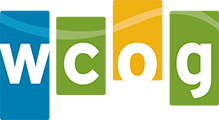Relative to our regional transportation system, policies are any number of formal decisions by local government administrations or facility agencies (e.g. WTA, WSDOT), made within the parameters of legal authorities, to influence the likelihood of a desired outcome. Typically implemented with public consultation, some examples of policy strategies are dedication of road lanes for high-occupancy vehicles, ramp-metering, pricing of publicly owned parking spaces, etc. While the WCOG Transportation Policy Board has responsibilities for formulating and approving regional investment priorities, its role has not included developing policies that would apply across multiple jurisdiction’s facilities or with respect to regional financing strategies.
Some of the Whatcom regional goals are addressed by WCOG more as a matter of policy than programs or specific projects, namely safety and environmental quality.
For WCOG, two regional goals (and state and federal planning requirements) that are implemented primarily as a matter of policy are safety and environmental quality. While individual jurisdictions often advance these goals with more direct actions, as an MPO, WCOG advances these desired outcomes through integration with various other planning strategies.
Safety
As described in table 12 of the Goals section, the objective of maximizing safety applies to everyone using the transportation system – motorized and non-motorized users. WCOG has adopted the following strategies to advance this goal.
- In administering the process for awarding the regional appropriation of FHWA STBG funds, WCOG has made safety the highest weighted scoring criteria. Under the safety criterion, projects that address system locations with history of fatal or serious injury crashes are emphasized. Projects that address any documented history of crashes (of all types) are also advanced under the criterion.
- WCOG uses the crash data resources compiled and made available thought the WSDOT Transportation Data, Geographic Information Systems (GIS), & Modeling Office – especially its Crash Data Portal – to monitor and visualize locations in the region that exhibit problematic crash trends. WCOG works with member jurisdictions to interpret these data and support efforts to identify and fund strategies to address safety issues.
- WCOG will continue to work with WSDOT to formally adopt upcoming standardized FHWA safety performance measures and targets. As suggested in current federal regulations, these will likely consist of region-wide measures of annual fatal and serious injury crashes, assessed on a five-year rolling average.
Environmental quality
As described in table 12 of the Goals section, WCOG’s connection to advancing the regional transportation goal of environmental quality overlaps with state and federal goals which, together, highlight some specific outcomes: greenhouse gas emissions reduction, energy conservation, protection of the natural environment including habitat and water quality, enhancement of community health, and promotion of consistency between planned land-use and economic development. WCOG has adopted the following strategies which advance these goals:
- In administering the process for awarding the regional appropriation of FHWA STBG funds, WCOG has made environmental quality a second-tier criterion (along with efficiency and multi-modal). Only the safety criterion is weighted more. Under the environmental quality criterion, projects that result in improvements to the environment related to the above-listed outcomes, is emphasized. WCOG has also added outcomes to the project selection guidance that include addressing environmental justice issues and project implementation strategies that make use of recycled materials.
- WCOG acknowledges Whatcom County’s adoption of Resolution 2015-038, “Committing Whatcom County to adopt a ‘Healthy Planning Approach’.” With this acknowledgement, WCOG will strive to pursue the other strategies listed in this plan with ongoing consideration of how they could be implemented to best support the desired outcomes of health and well-being of our region’s residents.
